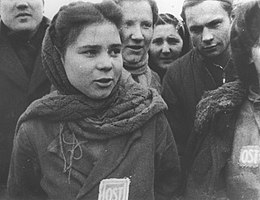 Female forced laborer wearing OST-Arbeiter badge at the former SS Osti Arbeitslager near Łódź, Poland, January 1945 | |
| Former type | Corporation |
|---|---|
| Industry | Manufacturing |
| Founded | General Government, Poland (March 1943) |
| Defunct | March 1944 |
| Headquarters | Occupied Poland |
| Key people |
SS-Obersturmführer Max Horn SS-Gruppenführer Odilo Globocnik |
| Owner(s) | SS |
| Employees | 17,000 forced laborers (peak)[1] |
The SS Ostindustrie GmbH ("East Industry", abbreviated as Osti) was one of many industries set up by the Nazi German Schutzstaffel (SS) using Jewish and Polish forced labor during World War II. Founded in March 1943 in German-occupied Poland, Osti operated confiscated Jewish and Polish prewar industrial enterprises, including foundries, textile plants, quarries and glassworks. Osti was headed by SS-Obersturmführer Max Horn, who was subordinated directly to Obergruppenführer Oswald Pohl of the SS-WVHA Economic Department.[2] At its height, some 16,000 Jews and 1,000 Poles worked for the company, interned in a network of labor and concentration camps in the Lublin District of the semi-colonial General Government territory.[1][2]
SS-Gruppenführer Odilo Globocnik hoped to make Ostindustrie into an armaments company, but gave up the idea to pursue Operation Reinhard instead.[3] The company was dissolved ahead of the Soviet counter-offensive of 1944.[1][2][3] The entire slave-labor workforce of Osti was exterminated in the process of shutting it down, during the deadliest phase of the Holocaust in Poland.[4]
Operations[]
By 16 May 1943, the SS Ostindustrie GmbH controlled several factories and workshops across Poland, grouped into five active Werke.[5] These included a glassworks in Wołomin (Werk I), a turf factory in Dorohucza (Werk II), a broom and brush factory in Lublin (Werk III), workshops in Bliżyn, Radom, and Tomaszów (Werk IV), and Splitwerk – a shoe factory, tailoring factory, carpentry and joinery at the Budzyn Arbeitslager, a turf factory in Radom and an iron foundry in Lublin (Werk V). Several additional Werke were under construction at that time, including vehicle spare parts factories, the Trawniki Arbeitslager (Werk VI), earth and stone works in Lublin (Werk VII), a medical sanitary ware factory (Werk VIII), various slave-labor workshops in Lemberg, and the Poniatowa Arbeitslager (later transferred to Többens).[6] By mid-1943, Globocnik projected the labor force of Osti to include some 45,000 Jews from a network of parallel camps with the main branch at Majdanek; however, the physical infrastructure in the region was insufficient for such numbers.[7][8]
Dissolution[]
Max Horn believed that Jewish forced labor was the way of the future, but his plans were halted by the Warsaw and Białystok ghetto uprisings, the latter of which occurred where the Ostindustrie textile and armament factories were scheduled for relocation.[7][9][10] On 3 November 1943, Osti's workforce was liquidated in Aktion Erntefest, the single largest German massacre of Jews in the entire war, with approximately 43,000 victims across District Lublin being shot in fake anti-aircraft trenches.[11] Subsequently, Horn complained in a report to Globocnik about the outcome of Aktion Erntefest; he stated that it had made Osti "completely valueless through the withdrawal [sic] of Jewish labor".[12] The company became officially defunct in March 1944.[1]
See also[]
- Baudienst, a conscript labor service operated by German authorities in Occupied Poland
References[]
- ↑ 1.0 1.1 1.2 1.3 Yad Vashem (2013). "Ostindustrie GMBH" (PDF file, direct download 19.6 KB). Shoah Resource Center, The International School for Holocaust Studies. http://www.yadvashem.org/odot_pdf/Microsoft%20Word%20-%205810.pdf. Retrieved 11 July 2013.
- ↑ 2.0 2.1 2.2 Dobroszycki, Lucjan (1984). "Introduction (Ostindustrie)". The chronicle of the Łódź Ghetto: 1941-1944. Yale University Press. p. lxi. ISBN 0300039247. http://books.google.ca/books?id=d1-U17adWKIC&pg=PR61&lpg=PR61&dq=%22Ostindustrie%22. Retrieved 11 July 2013.
- ↑ 3.0 3.1 Longerich, Peter (15 April 2010). "Murders and Deportations 1942–3". Holocaust: The Nazi Persecution and Murder of the Jews. Oxford University Press. p. 377. ISBN 978-0-19-280436-5. http://books.google.com/books?id=cxYqYIn73SgC&pg=PA377. Retrieved 11 July 2013.
- ↑ Stone, Dan (1 September 2010). Histories of the Holocaust. Oxford University Press. ISBN 0191614203. http://books.google.ca/books?id=6jchSqwLyUUC&dq=%22Ostindustrie%22&q=Ostindustrie. Retrieved 11 July 2013.
- ↑ Schulte 2007, p. 72.
- ↑ Schulte 2007, p. 55.
- ↑ 7.0 7.1 Chmielewski, Jakub (2013). "Ostindustrie (Osti)" (in Polish). Obozy pracy w dystrykcie lubelskim. Leksykon Lublin (Ośrodek "Brama Grodzka – Teatr NN"). http://teatrnn.pl/leksykon/node/1668/obozy_pracy_w_dystrykcie_lubelskim#3. Retrieved 12 July 2013.
- ↑ "Zagłada lubelskich Żydów" (in Polish). Obozy pracy w dystrykcie lubelskim. Leksykon Lublin (Ośrodek "Brama Grodzka – Teatr NN"). 2013. Archived from the original on 12 July 2013. http://www.webcitation.org/6I4M8Onso. Retrieved 12 July 2013.
- ↑ Datner, Szymon (December 1945). "The Fight and the Destruction of Ghetto Białystok". Kiryat Białystok, Yehud. http://www.zchor.org/bialystok/testimony.htm.
- ↑ Megargee, Geoffrey P., ed (2009). The United States Holocaust Memorial Museum encyclopedia of camps and ghettos, 1933–1945. Volume II: Ghettos in German-occupied Estern Europe. Bloomington: Indiana University Press. pp. 886–871. ISBN 978-0-253-35599-7. http://books.google.pl/books?id=iitQhYsM-dMC.
- ↑ Browning, Christopher R. (1992; 1998). "Arrival in Poland" (PDF file, direct download 7.91 MB complete). Ordinary Men: Reserve Police Battalion 101 and the Final Solution in Poland. Penguin Books. pp. 135–142. Archived from the original on 1 May 2013. http://www.webcitation.org/6GIJ2XpOy. Retrieved 7 May 2013.
- ↑ United States Nuremberg Military Tribunals (13 March 1944). "Max Horn : Business Report II of the Ostindustrie G.m.b.H. for the year 1943". A digital Document Collection of the Harvard Law School Library. Nuremberg Trials Project. pp. 3 of 6. http://nuremberg.law.harvard.edu/php/pflip.php?caseid=HLSL_NMT01&docnum=4035&numpages=6&startpage=1&title=Business+Report+II+of+the+Ostindustrie+G.m.b.H.+for+the+year+1943!.&color_setting=C. Retrieved 11 July 2013. "HLSL Item No.: 4035"
Bibliography[]
- Schulte, Jan Erik (1 January 2007). de Gruyter, Walter. ed (in German). Juden in der Ostindustrie GmbH. Institut für Zeitgeschichte. pp. 54–56. ISBN 3110956853. http://books.google.com/?id=xEhvT7gp_ksC&dq=Norbert+Frei+%E2%80%93+Jan+Erik+Schulte:+Zwangsarbeit+f%C3%BCr+die+SS. Retrieved 11 July 2013.
- "Białystok – History". Virtual Shtetl (Museum of the History of Polish Jews). pp. 6–7. http://www.sztetl.org.pl/en/article/bialystok/5,history/?action=view&page=5. Retrieved 11 July 2013.
| |||||||||||||||||||||||||||||||||||||||||||
| |||||||||||||||||||||||||||||||||||||||||||||||||||||||||||||||||||||||||||||||||||||||||||||||||||||||||||||||||||||||||||||||||||||||||
The original article can be found at Ostindustrie and the edit history here.
